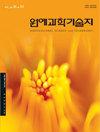抑制乙烯结合及生物合成维持台塑李采后贮藏品质
IF 0.8
4区 农林科学
Q3 HORTICULTURE
Korean Journal of Horticultural Science & Technology
Pub Date : 2021-06-01
DOI:10.7235/HORT.20210033
引用次数: 1
摘要
研究了以氨基乙氧基乙烯基甘氨酸(AVG)和1-甲基环丙烯(1-MCP)为原料的乙烯抑制方法,以提高李子采后品质和延长其货架期。李属“福尔摩沙”)。采前喷施150 mg·L -1 AVG,采后喷施1 μL·L -1 - mcp处理24 h。结果表明,AVG与1- mcp (AVG+1- mcp)联合处理能有效抑制李果采后贮藏过程中果皮颜色变化、果肉紧致度降低、腐烂和失重。AVG+1-MCP处理组在贮藏过程中也能显著维持酸度比。乙烯合成基因(PsACS3、PsACS4和PsACO1)的转录水平与李子产乙烯量呈现相同的模式。AVG+1-MCP处理显著抑制了PsACS3、PsACS4和PsACO1的转录水平,并降低了信号基因(PsETR1、PsERS1和PsCTR1)的表达,导致与未经处理的对照李子相比,李子的保质期更长。抑制乙烯的合成和结合有效地抑制了李果的衰老和成熟,表现出乙烯合成和呼吸的更年期上升。附加关键词:乙烯抑制剂,基因表达,李树subg。李子,成熟,保质期本文章由计算机程序翻译,如有差异,请以英文原文为准。
Inhibition of Ethylene Binding and Biosynthesis Maintains Fruit Quality of ‘Formosa’ Plums during Postharvest Storage
This study was conducted to develop an ethylene inhibition method using aminoethoxyvinylglycine (AVG) and 1-methylcyclopropene (1-MCP) to improve postharvest quality and extend the shelf life of plums (Prunus subg. Prunus ‘Formosa’). Plums were sprayed preharvest with 150 mg·L -1 AVG and postharvest with 1 μL·L -1 1-MCP for 24 h. The results revealed that the combined treatment with AVG and 1-MCP (AVG+1-MCP) effectively suppressed skin color change, flesh firmness reduction, decay, and weight loss of plum fruit during postharvest storage. The acidity ratio was also significantly maintained during storage in AVG+1-MCP treated groups. The transcript levels of ethylene biosynthesis genes (PsACS3, PsACS4, and PsACO1) showed the same pattern as the amount of ethylene produced in plums. AVG+1-MCP treatment significantly inhibited transcript levels of PsACS3, PsACS4, and PsACO1 and the reduction in expression of signaling genes (PsETR1, PsERS1, and PsCTR1), resulting in a longer shelf life compared to the untreated control plums. Inhibition of ethylene biosynthesis and binding effectively suppressed senescence and ripening of plum fruit that show a climacteric rise of ethylene synthesis and respiration. Additional key words: ethylene inhibitor, gene expression, Prunus subg. Prunus, ripening, shelf life
求助全文
通过发布文献求助,成功后即可免费获取论文全文。
去求助
来源期刊
CiteScore
2.00
自引率
0.00%
发文量
0
审稿时长
1 months
期刊介绍:
Horticultural Science and Technology (abbr. Hortic. Sci. Technol., herein ‘HST’; ISSN, 1226-8763), one of the two official journals of the Korean Society for Horticultural Science (KSHS), was launched in 1998 to provides scientific and professional publication on technology and sciences of horticultural area. As an international journal, HST is published in English and Korean, bimonthly on the last day of even number months, and indexed in ‘SCIE’, ‘SCOPUS’ and ‘CABI’. The HST is devoted for the publication of technical and academic papers and review articles on such arears as cultivation physiology, protected horticulture, postharvest technology, genetics and breeding, tissue culture and biotechnology, and other related to vegetables, fruit, ornamental, and herbal plants.

 求助内容:
求助内容: 应助结果提醒方式:
应助结果提醒方式:


